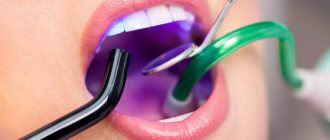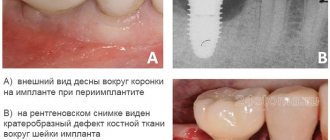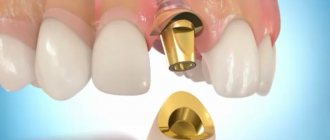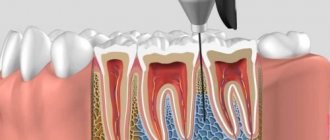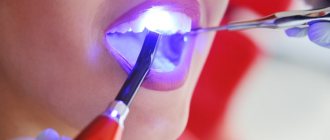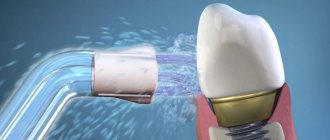Content
- What are the dangers of improper crown care?
- What to do after installing crowns
- When to see a doctor
Crowns are the most popular method of restoring damaged and lost teeth. Following the rules of care will help keep your teeth beautiful and healthy after dentures. Despite the fact that the tooth is artificial, plaque continues to accumulate on it. Also, do not forget that there are neighboring living teeth and soft tissues that may be damaged due to careless handling.
PROMOTION
Installation of crowns, dental bridge
RUB 3,450
How long will different types of crowns last, and what determines their “life”?
To have an idea of how often crowns need to be replaced, you should learn about the service life of various orthopedic structures. So let's look at this aspect from the perspective of different ways of classification.
For example, according to the period of wearing, temporary and permanent ones are distinguished. Temporary ones (made of composite or acrylic) last a very short time - from several days to 3-12 months. Permanent ones can last an average of 5-7 years. After how many years crowns are replaced depends on their service life, materials, manufacturing features, and how properly a person cares for them.
If we consider materials, then ceramic and metal-ceramic products will last up to 10 years maximum - with very good care. Zirconium dioxide or those made from lithium disilicate last longer - from 15 years. The manufacturing method is also important here - for example, zirconium dioxide structures milled with special devices can last more than 25 years. And ceramics processed using the classical method (manually) lasts about 7 years.
What are the dangers of improper care after prosthetics?
Bad breath and visible plaque are only superficial manifestations of poor hygiene. In fact, the consequences are much more serious:
- Plaque, accumulating near the surface of the gums, contributes to the formation of tartar.
- Tartar, in turn, is a breeding ground for bacteria.
- The waste products of harmful microorganisms have a destructive effect on the natural tissues of teeth and soft tissues, and provoke inflammation of the gums.
- When the gum becomes inflamed, its structure becomes loose. Such gums are not able to protect the cervical area of the teeth.
- If left untreated, seemingly harmless inflammation of the gums leads to much more serious consequences - periodontitis, the formation of gum pockets.
Simply put, dental hygiene and oral health are inextricably linked.
How to make addiction easier
But it is entirely within your power to make it easier to get used to dentures. This will require you to do a few simple steps that don't require much effort.
- When experiencing attacks of nausea and vomiting, take a deep breath several times, try to turn your thoughts to some neutral topics, distract yourself - turn on the TV or read a book.
- Sucking on lollipops will also help with nausea.
- But if there is excessive salivation, lollipops are contraindicated. It is better to rinse your mouth with a weak salt solution.
- Reading aloud will help you cope with diction problems. You can start with quiet reading, gradually moving to loud recitation with expression.
- Tongue twisters with a large number of “dental” letters (z, zh, sh, sch, h, s) will also help speed up the restoration of diction. For example, “Sasha walked along the highway and sucked on a dryer.”
- During the adaptation period, refrain from eating hard foods that require effort when biting and chewing. Also exclude from your diet those foods whose particles can get under the prosthesis and cause additional discomfort - crackers, nuts, croutons.
And, above all, be patient, remember that most difficulties are temporary and will soon disappear on their own. Therefore, it is necessary to overcome the first desire to immediately pull the interfering prosthesis out of your mouth (when using removable structures) - the more time the prosthesis spends in the mouth, the less time it will take to get used to it.
Rules of conduct after installing crowns
There are several rules that you can follow to keep your mouth healthy:
- Brush your teeth twice a day – immediately after waking up and before going to bed.
- Rinse your mouth if possible after every meal. This will get rid of food debris and slow down plaque formation.
- Thoroughly clean areas where plaque and food may accumulate. We are talking about the space under the hinged crown of the bridge. To do this, you can use an irrigator, brushes and other devices.
- You should avoid eating too hard foods and chewing on non-food items. Nail chewing, nuts, candy chewing – all of these should be avoided to maximize the life of your crowns.
- You should reduce your consumption of coffee, black tea, red wine, and other coloring foods.
- Gum care is also a very important attribute of healthy teeth. Rinsing and careful attention to the condition of soft tissues are required.
- Cleaning your tongue is a very useful activity. Plaque also accumulates here and must be removed.
Careful care will help maintain health and maximize the service life of any restorations.
Procedure for re-prosthetics
Replacement is carried out in several stages. Specific actions are determined by the condition of the supporting tooth, the material and design of the microprosthesis.
In general, the sequence of work looks like this:
- Examination of the oral cavity, making a decision on replacing a microprosthesis, choosing its type.
- Removing the crown.
- X-ray.
- Treatment of the abutment tooth (if necessary).
- Preparation (turning).
- Taking an impression from the supporting tooth and its antagonists.
- Manufacturing and installation of a provisional prosthesis (if necessary).
- Making a new design.
- Fixing it on the tooth.
Below are some features of replacing crowns of three main types - conventional, post and implant.
Crown on a tooth
Before you do anything with the tooth, you need to remove the old structure.
Removal
There are two options for removal - with the destruction of the microprosthesis and maintaining its integrity. If the condition of the product is unsatisfactory (extreme wear, cracks, chips), there is no need to keep it intact. In this case, it is simply cut with an abrasive wheel and removed with forceps.
They try to remove unworn or expensive zirconium structures without destruction for the purpose of subsequent installation. There are different types of non-destructive removal tools. The Kopp crown remover is most often used.
The principle of its operation is based on the generation of a shock impulse that moves the crown relative to the tooth. Usually, the bonding cement is first destroyed by ultrasound, then the microprosthesis is removed. The patient feels quite noticeable shocks. If the tooth is sensitive, local anesthesia is performed.
Removing an all-ceramic structure without destruction is a difficult task, so such products are usually made anew.
Dental treatment
Treatment is carried out taking into account the condition of the tooth that led to the need to replace the crown. This can be depulpation, resection of the root apex, cyst removal, removal of dental plaque, antiseptic treatment, antibiotic therapy.
After treatment is completed, the tooth is restored with a composite or inlay and ground down for a crown.
Prosthetics
The work on manufacturing and installing a new microprosthesis is no different from primary prosthetics. Impressions are made of the supporting tooth and its antagonists, plaster models are cast from them, on the basis of which crowns of the selected type are made.
On the pin
Dentures on pins are usually installed when there is significant or complete destruction of tooth dentin. In this case, different pin designs are used: parapulpal (for vital pulp), intracanal (for pulpless teeth), pins cast integrally with the microprosthesis. The material used for the pins is metal or carbon.
The technology of re-prosthetics depends on the chosen design. If the prosthesis is disconnected at the point of contact between the pin and the stump of the tooth, a new stump is restored on the pin and a crown is installed on it.
When a pin falls out of the root canal, it is prepared for installation of a new pin. The most difficult case is a broken metal rod at the level of the canal mouth. In this case, it may be necessary to remove the tooth and install a bridge or implant.
On an implant
In microprosthetics on implants, the tooth stump together with the crown is attached to the abutment using a screw (detachable connection) or cement (one-piece connection).
The most common reason for removing a crown from an implant is the need to treat peri-implantitis , an inflammatory and necrotic process at the site of contact between the implant and the bone.
The main goal of all treatment measures in this case is to avoid rejection of the artificial root. The process of installing a microprosthesis on an implant is simple and does not cause any difficulties.
Psychological aspect
Often the use of a prosthesis provokes psychological discomfort in the patient: it frightens him, it seems to him that complications have already arisen, and adaptation is not going well. To prevent such a problem from arising, you need the right attitude: a person must be prepared for the difficulties that may arise in the first days. It is important to take your time and understand that the body needs to get used to new conditions. The period of complete adaptation takes up to one and a half months on average, but the most noticeable discomfort disappears after 1-2 weeks if you wear the prosthesis constantly.
To get used to a removable denture faster, orthodontists at the Dentospas clinic recommend massaging the gums. You can do it yourself, it will improve blood circulation and tissue nutrition, and improve the condition of the gums. Massage is done provided that the surface of the mucous membrane is not injured and there are no open wounds on it. At first, to speed up adaptation, you can leave the prosthesis on at night (install it again after cleaning). This is safe (the gums and tongue hardly move during sleep) and allows you to increase the time of contact of the mucous membrane with the base of the structure.
Dry mouth or increased salivation
A feeling of dryness or, on the contrary, increased salivation occurs due to the adaptation of the mucous membranes to a foreign body. If the design is made correctly, the discomfort quickly passes. If your mouth is dry, you should drink water more often and rinse, but do not use alcohol solutions. It is worth limiting the consumption of tea, coffee, and at least temporarily giving up smoking. You need to get rid of dryness quickly, otherwise your gums will be injured.
Excessive salivation is a reaction to a foreign body in the mouth, to constant contact with the mucous membrane. It goes away on its own in a few days. You can simplify the adaptation process for the mucous membrane by rinsing with decoctions of chamomile, oak bark or sage, or solutions recommended by your doctor.
What experts recommend
To avoid complications and install a high-quality, durable prosthesis, you need to contact an experienced orthopedist who will conduct a full examination before prosthetics and model an anatomically correct design. It is also important that the support is properly prepared - the canals are thoroughly cleaned and sealed, the upper part is sharpened, and a suitable implant is selected. To restore teeth, today they offer several methods for making crowns, and the optimal one is milling using CAD/CAM technology. This results in very tight-fitting structures, under which germs and food particles do not penetrate, so they last longer than others.
Complications in case of untimely replacement
If you visit the dentist irregularly or endure pain for a long time, then dangerous complications are likely to occur, such as gum loss, local periodontitis, marginal periodontitis, tooth decay, the appearance of cysts and granulomas at the roots, peri-implantitis - inflammation around the implant. All these conditions are fraught with removal of the root/implant and prolonged recovery (if the bone was severely infected).
PROSTHETIC PROSTHETICS WITH 4 STRAUMANN IMPLANTS “teeth in 1 day” - RUB 220,000. until January 15, 2022!
Complex implantation using ProArch technology (Switzerland) with immediate loading on the day of surgery!
Call now or request a call
“I somehow missed the moment that the crown began to wobble, so I didn’t go to the dentist. But a few days later, during lunch, I felt that it had fallen off altogether. Almost swallowed it! I thought it would be possible to glue it in place. But the prosthetist said it was too late, the root was cracked and needed to be removed. Here. So now I’ll have to make a bridge or an implant. Not decided yet". Sergey, review from the website stomatology.rf
